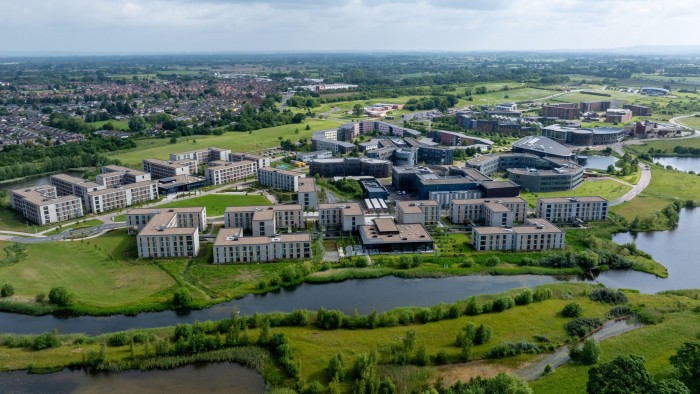Even on a winter afternoon, the University of York looks like a thriving enterprise. The university that opened to 230 students in 1963 as part of the UK’s postwar expansion of higher education now hosts 20,000. New buildings stretch eastward on former farmland from Heslington Hall, the 16th-century manor house around which its original campus was built.
York is among the Russell Group of research universities led by Oxford and Cambridge (“a Russell Group university in a medium-sized city in the north,” is one professor’s summary). Research funding contributed £100mn of its £533mn income last year and Charlie Jeffery, vice-chancellor, has plenty to extol in his Heslington Hall office.
But cracks have appeared in York’s financial foundations in the past couple of years. It suffered a £9mn deficit last financial year amid a fall in the number of higher-fee international students on whom it relies to support research and teaching of UK students. It shed 275 jobs, mainly among administrative staff, as part of an unpopular restructuring.
York is part of a broader crisis in higher education caused by the real-terms squeeze in fee income from UK students, and a fall in international applications. The Office for Students, the sector’s regulator, has warned that “bold and transformative” action is needed for some institutions to avoid bankruptcy in the academic year starting in September.
It also symbolises the challenges facing research universities outside the “golden triangle” of Oxbridge and top London universities. The government wants such institutions to contribute to economic growth outside the south-east. But much research funding and private investment, including spinouts of university start-ups, remains focused around London.
The danger is of a vicious cycle of cost cutting that hurts teaching and research. York’s cadre of international students, many of them Chinese, has contracted by 23 per cent in the past two years to 4,840. This is about a quarter of the total but they pay far higher annual fees than UK students: at least £23,700 compared with £9,250 last year.
The cap on UK student fees has been lifted to £9,535 for the academic year starting in September, but the benefit to York is more than offset by the rise in employer’s national insurance rates. Even if UK student fees are indexed in future, as universities want, Jeffery says this would “stop the situation from getting worse, rather than make it better”.
Vice-chancellors cannot just sit around complaining: they must find fresh sources of income. Jeffery argues that the key deficit for universities such as York is in research: this is only 70 per cent financed by public sources such as academic research councils. With international fees becoming less secure, it needs to fill the gap by other means.
Jeffery spies opportunity in the government’s industrial strategy and economic growth plans. Graduates and postgraduates are vital to industries such as life sciences and technology and the institutions themselves could play a larger regional role, he argues. “If universities become drivers of development . . . that might be worthy of public funding,” he says.
The key is to form the interface of public research and private enterprise. This is not a new idea, of course: large US research universities such as Stanford and the Massachusetts Institute of Technology have done so for decades and in Germany, the Fraunhofer research centres are 70 per cent funded by industry through contract projects, with 30 per cent public financing.
York’s leading exhibit is its £45mn Institute for Safe Autonomy, a research centre for robotics, which opened last year with funding including a partnership with the Lloyd’s Register Foundation. It has also formed links with Yorkshire Water for biological research and the Royal Shakespeare Company for work in virtual reality.
While this is promising, it is not yet a stable supplement to the international fees on which many universities have based growth over the past decade. Institutions such as York also compete with the golden triangle for investment. Universities perform a quarter of the UK’s research and development, with much of it focused in the south.
If York cannot diversify, that will damage not only students and the higher education sector, but the UK’s economic growth and regional balance. The university may have realised too late that it needs broader foundations, but it has little choice now.



